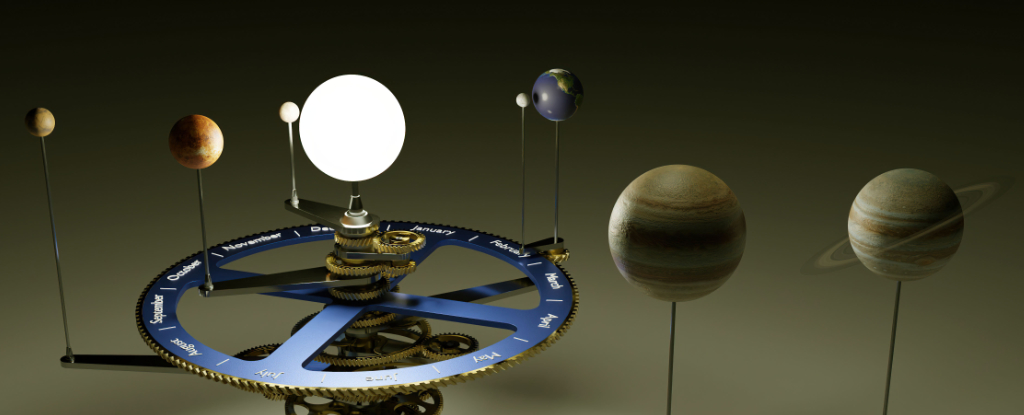One planet was missing from the sunset lineup… until now.
Perhaps you’ve seen the news headlines admonishing sky watchers to ‘See All Naked Eye Planets … at Once!’ in January. While this was basically true, it was also missing one key player: Mercury.
This week, the swift inner planet joins the scene at dusk.
It’s certainly rare to see all the planets in the Solar System in one sweep. This sort of lineup depends mainly on slow moving Jupiter and Saturn, which have parted ways since the rare conjunction of the two on December 21st, 2020.
A Planetary Dusk Tour
Seeing all the naked eye planets at once is set to become a rarity in coming years.
In any event, here’s a tour of the planets at dusk for the remainder of February into early March from the inner Solar System outward, with ready-made star party facts for each:
Fresh off solar conjunction on February 9th, the vigil is now on the week to recover Mercury low to the west after sunset. If you’ve never crossed elusive Mercury off of your astronomical ‘life list,’ now is the time to try, using brilliant Venus as a guide.
Mercury passes 1.5 degrees north of Saturn on February 25th, and the waxing crescent Moon joins the scene on February 28th, and occults Mercury on March 1st for Hawai’i and the Pacific.
Though the oft-told tale that astronomer Nicolaus Copernicus never saw Mercury is probably apocryphal, it does speak to just how elusive the fleeting world is. Mercury reaches greatest elongation for the first of six times in 2025 on March 8th, 18 degrees east of the Sun shining at magnitude -0.35 and displaying a half illuminated disk in the telescope, just 7″ across.
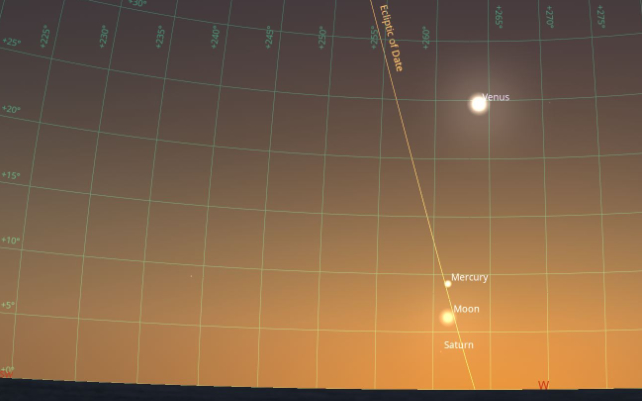
The crescent Moon then passes 5.7 degrees south of Venus on March 2nd, marking a good time to see the two in the daytime. Fun fact this President’s Day week: attendants of Lincoln’s second inauguration on March 4th 1865 actually noticed the Venus in the daytime sky as the midday clouds cleared.
A Planetary Race
Venus and Mercury both go on to race each other towards inferior conjunction next month, passing the Sun just 24 hours apart on March 23 and 24th. Both will then reemerge into the dawn sky in late March.
Spotting Venus through inferior conjunction is tricky but not impossible, as the -4.2 magnitude slender 1% crescent passes just over 8 degrees north of the Sun at its closest. Be sure to try this feat visual athletics before sunrise, or after sunset.
Into the Outer Solar System
Mars leads up the back of the pack, shining at -0.58 magnitude in Gemini the Twins. Look for ruddy Mars high to the east at dusk, fresh off of opposition on January 16th. The waxing gibbous Moon meets up with Mars on March 9th. NASA’s ESCAPADE Mars mission is set to launch for the Red Planet this year.
Onward and outward, Jupiter rides high to the south in Taurus the Bull at dusk. The waxing near First Quarter Moon meets Jupiter on March 6th, and the planet reaches quadrature 90 degrees east) of the Sun on March 2nd.
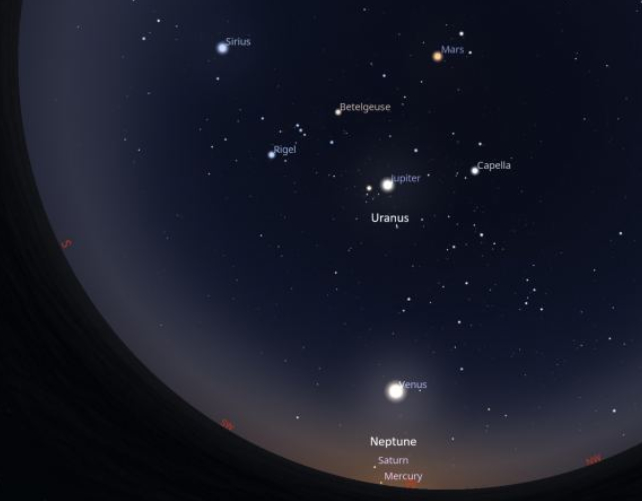
Danish astronomer Ole Rømer noticed that predictions for phenomena for Jupiter’s moons (transits, ingress/egress times, etc) were off from opposition versus quadrature, and correctly deduced it was because the time it took light to traverse the two different distances was not factored in.
Sometimes, scientific inspiration doesn’t stem as much from a ‘eureka!’ moment, but simply from a patient observer saying ‘that’s funny…’
Meanwhile, the outermost of the classical planets presents a challenge, as Saturn sits in the murk low to the west.
Once you’ve found Mercury, sweep the horizon with binoculars and scoop up +1.1 magnitude Saturn, just over three times fainter than Mercury. The rings of Saturn pass edge on as seen from our Earthly vantage point on March 23rd, just two weeks after solar conjunction.
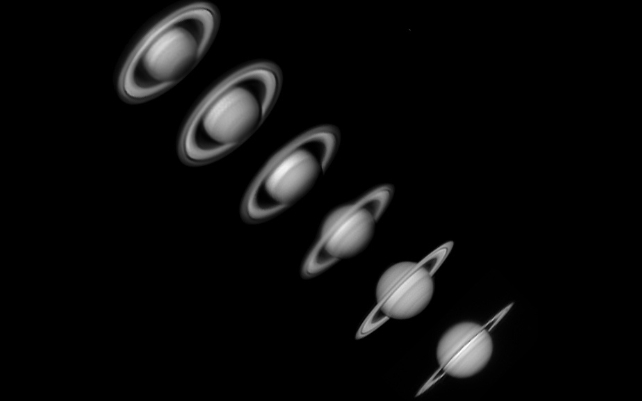
…And Something More
Finally, completists will want to also pick off the outer ice giant worlds Uranus and Neptune. +5.8 magnitude Uranus is an easy binocular catch in Taurus (not far from Jupiter), while +7.8 magnitude Neptune is more of a challenge, hanging out in the murk low to the horizon with Mercury and Saturn in Pisces the Fishes.
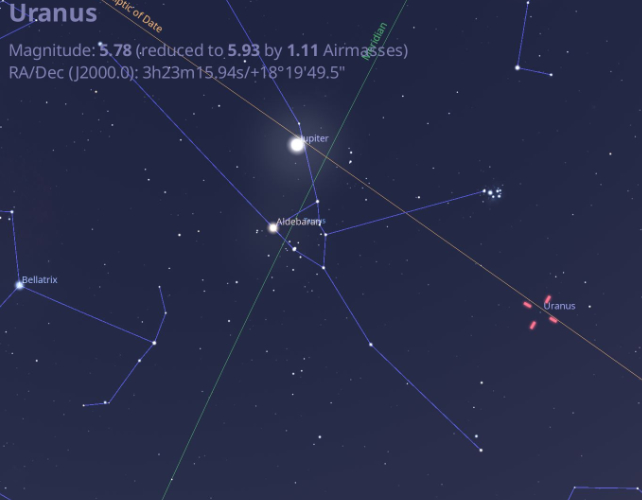
Both planets have the distinction of being discovered in the telescopic era, and Neptune is the only planet discovered using the power of math and deduction.
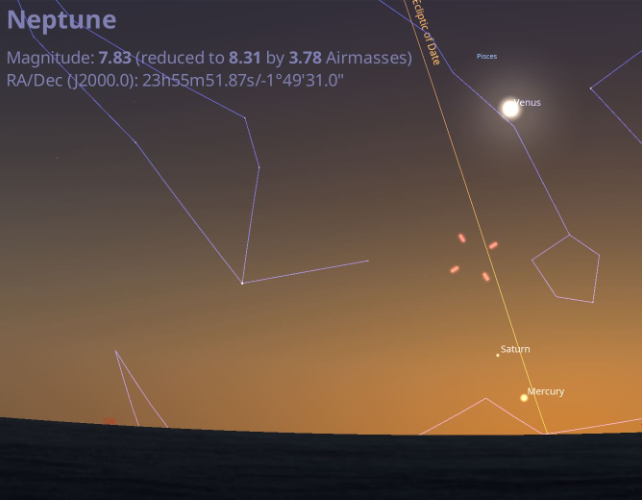
The celestial drama sorts itself out in March, with Saturn leaving the scene and Mercury and Venus reappearing in the dawn sky.
But hey, we have the first of two eclipse seasons for 2025 coming right up next month, with a partial solar eclipse on March 29th and a total lunar eclipse on 14th.
Let’s hope that the fickle Spring weather cooperates. Good skywatching, and clear skies in your planetary quest.
This article was originally published by Universe Today. Read the original article.


